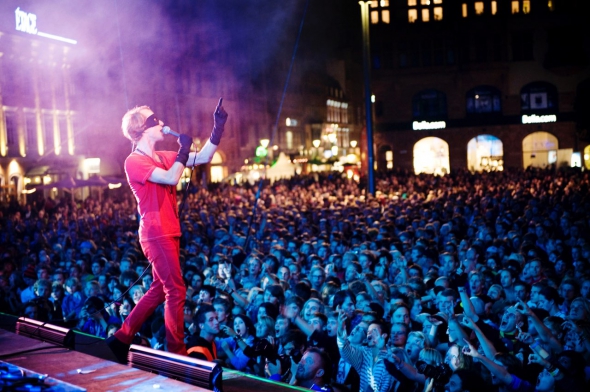Here is some facts you might not have known
Facts about Malmö
Malmö became a Swedish city in 1658
Malmö was first mentioned as a city in 1275 and received its coat of arms in 1437. Having been Danish, Malmö became Swedish in 1658 through the Treaty of Roskilde. The city had around 3,000 inhabitants at the time.
Sweden’s third city
(Population in January 2015)
Malmö: 322,577 (51% female and 49% male). The Malmö region: 670,394. Skåne: approx. 1.3 million. The Öresund region: approx. 3.8 million. Copenhagen: 559,440.
An expanding city
Malmö’s population increased for the twenty-eighth year in a row. In November 2013 Malmö had 312,400 residents. The population increased by almost 5,000 during 2012, and since the year 2000 the number of Malmö residents has grown by 50,000. In April 2011 Malmö passed the figure of 300,000 inhabitants, and by 2018 the city is expected to have approx. 338,400 inhabitants.
High level of inward migration
During 2012 19,800 people moved into Malmö and 17,300 moved out. Almost half of the newcomers were in the 20-29 age group. An additional 38,400 people moved within the city.
Young inhabitants
The average age of Malmö residents in 36. The average age in Skåne is 40, and in Sweden as a whole 41. 22% of the population in Malmö are below the age of 20, 63% are between 20 and 64m and 15% are pensioners aged 65 or more.
Malmö residents from 177 countries
Where of 171 are from the 193 UN nations with just 23 nationalities missing to be the first and only truly global city.
31% or 94,700 of Malmö residents were born abroad, 50% of them female and 50% male. The largest groups were born in: Iraq 11,000, Denmark 8,000, former Yugoslavia 8,000, Poland 7,000 and Bosnia 6,000. The groups that saw the biggest increases in 2012 were those born in Iraq (+320), Syria (+220), Afghanistan (+180) and Turkey (+120). 60% of Malmö’s immigrants are Swedish citizens.
Varied housing stock
Malmö has approx. 149,700 homes (31 Dec. 2012), of which 46% are rented (32% of the tenancy rights are owned by MKB Fastighets AB) 37% are owner-occupied and 15% are owned. 45% of homes have two rooms and a kitchen or less. 82% of homes are in apartment blocks and 18% in houses. An average of approx. 1,000 new homes have been built each year over the last three years.
Turning Torso
The architect behind Turning Torso is Santiago Calatrava, and the building was ready for occupation on 1 November 2005. It is 190 m high and consists of 54 floors with 147 apartments and offices.
Small households
70% of the city’s approx. 135,500 households are small households with one or two people.
High level of inbound commuting
There are 158,300 jobs in total in Malmö (2011). Every day 61,900 people (26,500 female and 35,400 male) commute into Malmö to work, and 28,400 Malmö residents (12,100 female and 16,200 male) commute to other places.
15% work in the field of trade
Of all the jobs in Malmö, 15% are in the Trade sector, 13% in Health and Social Care together with Social Services and 9% in Education.
City of Malmö the biggest employer
The City of Malmö, with 20,100 employees (15,500 female and 4,600 male), is the biggest employer in Malmö. 39% work in Schools and Childcare and 26% in Health and Social Care (Dec. 2012). 65% of those who work in Malmö work at workplaces with fewer than 100 employees (2011).
Those in employment and the unemployed
63% of Malmö residents aged 20 to 64 are in employment (2011), with a further 9,200 Malmö residents working in Denmark. The employment rate including cross-border commuters is approx. 68%.
The unemployment rate in Malmö is 15.3% and the national average is 8.5%. Unemployment in Malmö is lower for women, 13.7%, than for men, 16.7% (Swedish Employment Service, October 2013).
Education level
In the population group aged 25-64, 46% of Malmö residents have post-secondary education: 50% for women and 43% for men.
The proportion for Sweden is 40%, and the figures in Stockholm and Gothenburg are 55% and 50% respectively (2012).
Modern university
Malmö University (founded in 1998) has approx. 24,000 students (13,000 full-time students, 2012). Malmö also has educational facilities that form part of Lund University, e.g. Malmö Academy of Music, Malmö Theatre Academy and Malmö Art Academy. The UN’s World Maritime University is also in Malmö.
250 million people over the Öresund Bridge
Since the Öresund Link was opened in July 2000, 250 million people (October 2012) have travelled over this bridge between Malmö and Copenhagen. During 2012, 11 million people travelled by train and 13.6 million crossed by car, bus or motorcycle.
A compact, cycle-friendly city
“In Malmö, everything’s amazingly close at hand.” It’s no more than 10 km from the centre to the city boundary, and there are 490 km of cycle paths within the city. There are long beaches with excellent bathing water quality within walking and cycling distance of the centre. Along the coastal strip are the bathing houses of Ribersborg (build in 1898) Sibbarp. By the coast of Malmö are approx. 2,000 berths for leisure boats at places including Limhamn, Dockan and the Western Harbour.
Five urban areas
Malmö is divided into five urban areas.
Population per urban area, 1 January 2023
West 75,600
North 62,100
East 44,300
Inner City 67,900
South 56,300
“Malmö in brief” and additional facts may be found at: http://www.malmo.se/statistik
Together, we can make this happen.
SUPPORT USFresh things from our blog
View all
 Here are the missing 22
Here are the missing 22
Here is the list of nations missing to make Malmö the world's most international city.
 Frequently asked questions
Frequently asked questions
Here are some of our answers to the most asked questions about Little Big Malmö.
